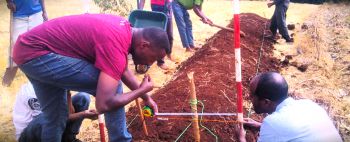Soil Bunds: A Simple Yet Effective Nature-based Solution for Land Restoration
By: Romi Phoenix
Last updated: Friday, 16 May 2025

Soil bunds installed at one of the REAL NbS project’s experimental sites in Ethiopia.
Over the upcoming months, our colleague Dr Cynthia Olumba from Cranfield University, working on Work Package 1 focusing on Soil, will share a series of posts on the co-selected Nature-based Solutions to Land degradation. This month, we are starting with reviewing Soil Bunds.
In many parts of East Africa, farmers face the escalating challenge of degraded land that can no longer support crops and livestock. Climate change, with its increased droughts and unpredictable rainfall, combined with ongoing farming on vulnerable soils, has intensified soil erosion, undermining soil health and agricultural productivity. Without fertile soil, food security becomes a struggle, particularly for land-dependent communities.
One promising approach gaining momentum is the use of Nature-based Solutions (NbS), which are defined as interventions that enhance natural land restoration and regeneration. Among these are Soil bunds, which are simple traditional earth structures with the potential to restore degraded land, help farmers combat land degradation, and improve soil productivity.
What Are Soil Bunds?
Soil bunds are small, raised embankments built along the contours of sloping farmland. Made using earth, stones, or a mix of both, these structures help slow down surface water, reduce soil erosion, and trap moisture in the soil. This gives crops a better chance to grow, especially during dry periods.
Think of them like speed bumps for water: instead of overland flow rushing downhill and carrying precious topsoil with it, bunds intercept and hold back the water, giving it time to soak into the soil.
Why Are Soil Bunds Important?
Soil bunds might seem simple, but their impact is huge:
- Prevent soil erosion – Keeping the topsoil in place means crops have the nutrients they need to grow.
- Improve water retention – Moisture stays in the soil longer, helping plants survive dry spells.
- Boost crop yields – Healthier soil means better harvests and more food on the table.
- Restore degraded land – Over time, bunds help bring life back to land that was considered unproductive.
Locally Chosen Solutions for Combating Land Degradation
Soil bunds are one of the NbS to be tested within the REAL NbS project, co-selected during the inception workshop, held in Ethiopia in the autumn of last year. With support from the project team, some farmers are now constructing soil bunds on test plots in their fields and monitoring this solution’s effectiveness in reducing land degradation.
Here’s the recipe for creating these land-restoring structures:
Ingredients:
- Eroded cropland in need of restoration
- A group of motivated farmers (people power!)
- Spades, hoes, and a simple ‘A’ frame to mark out the contour lines
- A clear vision for land recovery
Method of Installation:
- Identify areas or fields most affected by soil erosion.
- Using the ‘A’ frame, mark out the contour of the land where the bunds will be installed.
- Dig a trench along the marked line to form the base of the bund.
- Build your bund by throwing the excavated soil on the upslope side of the trench. Shape it so it's compact and stable.
- Plant local grasses/vegetation on top of the bunds and along the trench. Plant in rows to help anchor the soil and prevent further erosion.
- Celebrate the hard work with a well-earned break once the bunds are in place!
- Regularly check your bunds and reinforce any spots that have started to erode.
With a little sweat, some good old-fashioned teamwork, and these simple steps, soil bunds can help turn erosion-prone land into something productive and sustainable! And most importantly, they work with nature, not against it.

